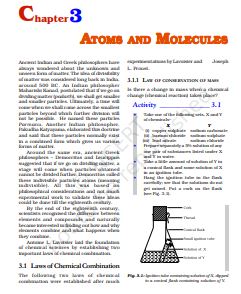‘NCERT Solutions for Class 9 Science Chapter 3‘ PDF Quick download link is given at the bottom of this article. You can see the PDF demo, size of the PDF, page numbers, and direct download Free PDF of ‘Ncert Class 9 Science Chapter 3 Exercise Solution’ using the download button.
NCERT Class 9 Science Textbook Chapter 3 With Answer PDF Free Download

Chapter 3: Atoms and Molecules
Ancient Indian and Greek philosophers have always wondered about the unknown and unseen form of matter.
The idea of divisibility of matter was considered long back in India, around 500 BC. An Indian philosopher Maharishi Kanad, postulated that if we go on dividing matter (padarth), we shall get smaller and smaller particles.
Ultimately, a time will come when we shall come across the smallest particles beyond which further division will not be possible. He named these particles Parmanu.
Another Indian philosopher, Pakudha Katyayama elaborated on this doctrine and said that these particles normally exist in a combined form which gives us various forms of matter.
Around the same era, ancient Greek philosophers – Democritus and Leucippus suggested that if we go on the dividing matter, a stage will come when particles obtained cannot be divided further.
Democritus called these indivisible particles atoms (meaning indivisible). All this was based on philosophical considerations and not much experimental work to validate these ideas could be done till the eighteenth century.
By the end of the eighteenth century, scientists recognized the difference between elements and compounds and naturally became interested in finding out how and why elements combine and what happens when they combine.
Antoine L. Lavoisier laid the foundation of chemical sciences by establishing two important laws of chemical combination.
3.1.2 Law of Constant Proportions
Lavoisier, along with other scientists, noted that many compounds were composed of two or more elements and each such compound had the same elements in the same proportions, irrespective of where the compound came from or who prepared it.
In a compound such as water, the ratio of the mass of hydrogen to the mass of oxygen is always 1:8, whatever the source of water. Thus, if 9 g of water is decomposed, 1 g of hydrogen and 8 g of oxygen are always obtained.
Similarly in ammonia, nitrogen and hydrogen is always present in the ratio of 14:3 by mass, whatever the method or the source from which it is obtained.
This led to the law of constant proportions which is also known as the law of definite proportions. This law was stated by Proust as “In a chemical substance the elements are always present in definite proportions by mass”.
The next problem faced by scientists was to give appropriate explanations for these laws. British chemist John Dalton provided the basic theory about the nature of matter.
Dalton picked up the idea of divisibility of matter, which was till then just a philosophy. He took the name ‘atoms’ as given by the Greeks and said that the smallest particles of matter are atoms. His theory was based on the laws of chemical combination.
atomic theory provided an explanation for the law of conservation of mass and the law of definite proportions. According to Dalton’s atomic theory, all matter, whether an element, a compound or a mixture is composed of small particles called atoms. The postulates of this theory may be stated as follows:
(i) All matter is made of very tiny particles called atoms.
(ii) Atoms are indivisible particles, which cannot be created or destroyed in a chemical reaction.
(iii) Atoms of a given element are identical in mass and chemical properties.
(iv) Atoms of different elements have different masses and chemical properties.
(v) Atoms combine in the ratio of small whole numbers to form compounds.
(vi) The relative number and kinds of atoms are constant in a given compound.
| Author | NCERT |
| Language | English |
| No. of Pages | 15 |
| PDF Size | 773 KB |
| Category | Science |
| Source/Credits | ncert.nic.in |
NCERT Solutions Class 9 Science Chapter 3 Atoms and Molecules
1. Write down the formulae of
(i) sodium oxide
(ii) aluminium chloride
(iii) sodium sulphide
(iv) magnesium hydroxide
Solution:
The following are the formulae:
(i) sodium oxide – Na2O
(ii) aluminium chloride – AlCl3
(iii) sodium sulphide – Na2S
(iv) magnesium hydroxide – Mg (OH)2
2. Write down the names of compounds represented by the following formulae:
(i) Al2(SO4)3
(ii) CaCl2
(iii) K2SO4
(iv) KNO3
(v) CaCO3.
Solution:
Listed below are the names of the compounds for each of the following formulae
(i) Al2(SO4)3 – Aluminium sulphate
(ii) CaCl2 – Calcium chloride
(iii) K2SO4 – Potassium sulphate
(iv) KNO3 – Potassium nitrate
(v) CaCO3 – Calcium carbonate
3. What is meant by the term chemical formula?
Solution:
Chemical formulas are used to describe the different types of atoms and their numbers in a compound or element. Each element’s atoms are symbolised by one or two letters. A collection of chemical symbols that depicts the elements that make up a compound and their quantities.
For example The chemical formula of hydrochloric acid is HCl.
4. How many atoms are present in a
(i) H2S molecule and
(ii) PO43- ion?
Solution:
The number of atoms present is as follows:
(i) H2S molecule has 2 atoms of hydrogen and 1 atom of sulphur hence 3 atoms in totality.
(ii) PO43- ion has 1 atom of phosphorus and 4 atoms of oxygen hence 5 atoms in totality.
Atoms and Molecules NCERT Textbook With Solutions PDF Free Download
